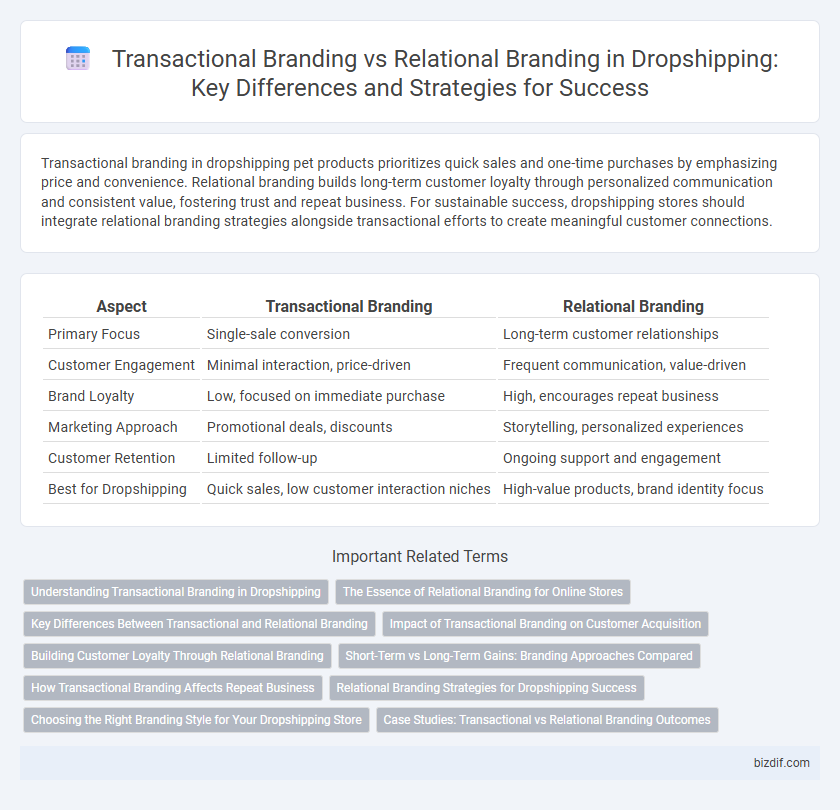Transactional branding in dropshipping pet products prioritizes quick sales and one-time purchases by emphasizing price and convenience. Relational branding builds long-term customer loyalty through personalized communication and consistent value, fostering trust and repeat business. For sustainable success, dropshipping stores should integrate relational branding strategies alongside transactional efforts to create meaningful customer connections.
Table of Comparison
| Aspect | Transactional Branding | Relational Branding |
|---|---|---|
| Primary Focus | Single-sale conversion | Long-term customer relationships |
| Customer Engagement | Minimal interaction, price-driven | Frequent communication, value-driven |
| Brand Loyalty | Low, focused on immediate purchase | High, encourages repeat business |
| Marketing Approach | Promotional deals, discounts | Storytelling, personalized experiences |
| Customer Retention | Limited follow-up | Ongoing support and engagement |
| Best for Dropshipping | Quick sales, low customer interaction niches | High-value products, brand identity focus |
Understanding Transactional Branding in Dropshipping
Transactional branding in dropshipping centers on single-purchase interactions, emphasizing immediate sales and product features rather than long-term customer relationships. This approach leverages high-converting product descriptions, competitive pricing, and fast shipping to drive quick decision-making and reduce purchase friction. Dropshippers using transactional branding optimize ad targeting and checkout processes to maximize conversion rates and short-term revenue.
The Essence of Relational Branding for Online Stores
Relational branding emphasizes building long-term customer relationships through personalized experiences and consistent engagement, crucial for online stores seeking customer loyalty and repeat purchases. It fosters trust and emotional connections by prioritizing customer satisfaction, community-building, and transparent communication rather than just immediate sales. Effective relational branding in dropshipping enhances brand reputation and drives lifetime value by creating meaningful interactions that transcend transactional exchanges.
Key Differences Between Transactional and Relational Branding
Transactional branding prioritizes quick sales and short-term customer interactions, emphasizing price and product features to drive immediate purchases. Relational branding focuses on building long-term customer loyalty through emotional connections, consistent communication, and personalized experiences that foster trust. Key differences lie in their goals: transactional aims for rapid conversions, whereas relational invests in deep customer relationships to encourage repeat business.
Impact of Transactional Branding on Customer Acquisition
Transactional branding in dropshipping significantly boosts customer acquisition by emphasizing quick, price-driven purchases and streamlined checkout processes that meet immediate consumer needs. This approach leverages promotional offers, clear product benefits, and fast delivery options to attract price-sensitive buyers and drive high conversion rates. Focusing on transactional branding enables dropshipping businesses to rapidly expand their customer base through targeted ads and time-limited discounts that encourage swift purchase decisions.
Building Customer Loyalty Through Relational Branding
Transactional branding focuses on one-time sales and short-term gains, while relational branding prioritizes creating long-term customer loyalty through emotional connections and consistent engagement. By leveraging personalized communication, quality customer service, and authentic brand values, relational branding builds trust and encourages repeat purchases in a competitive dropshipping market. Implementing loyalty programs and tailored experiences enhances customer retention, driving sustainable revenue growth beyond single transactions.
Short-Term vs Long-Term Gains: Branding Approaches Compared
Transactional branding in dropshipping emphasizes immediate sales boosts through targeted promotions and discounts, driving short-term revenue increases but often sacrificing customer loyalty. Relational branding invests in building trust, consistent customer engagement, and personalized experiences, fostering long-term customer retention and higher lifetime value. Balancing these approaches helps dropshipping businesses maximize quick conversions while establishing sustainable brand equity.
How Transactional Branding Affects Repeat Business
Transactional branding in dropshipping emphasizes one-time sales through price promotions and product features, potentially driving immediate purchases but often limiting customer loyalty. This approach may result in lower repeat business since customers focus on cost and convenience rather than brand connection. Building trusted relationships and consistent value is critical for enhancing repeat business, which transactional branding alone struggles to achieve.
Relational Branding Strategies for Dropshipping Success
Relational branding strategies enhance customer loyalty and lifetime value by fostering trust and emotional connections through personalized communication, consistent brand storytelling, and exceptional post-purchase support. Dropshipping businesses benefit from leveraging social media engagement, user-generated content, and transparent shipping policies to build authentic relationships with customers. Implementing loyalty programs and responsive customer service ensures repeat purchases and positive word-of-mouth, driving sustainable growth.
Choosing the Right Branding Style for Your Dropshipping Store
Transactional branding in dropshipping emphasizes quick sales and price competitiveness, ideal for stores targeting impulse buyers or low-involvement products. Relational branding builds customer loyalty through personalized experiences and trust, suited for niche markets where repeat purchases and brand differentiation matter. Selecting the right branding style depends on your target audience, product type, and long-term business goals to optimize conversion and customer retention.
Case Studies: Transactional vs Relational Branding Outcomes
Case studies in dropshipping reveal that transactional branding prioritizes quick sales through price promotions and product-focused messaging, often resulting in high churn rates and low customer retention. In contrast, relational branding emphasizes building trust and emotional connections via personalized communication and consistent post-purchase support, leading to increased customer loyalty and higher lifetime value. Brands adopting relational strategies in dropshipping consistently outperform transactional-focused competitors in customer satisfaction and repeat purchase rates.
Transactional Branding vs Relational Branding Infographic

 bizdif.com
bizdif.com